Unearthing the social life of ants
On a trip to Papua New Guinea, DPhil student Juliet Turner had the opportunity to add context and depth to her usual computer-based work back in Oxford while connecting with and learning from researchers from around the world.
For nearly a month last summer, I travelled around some of the most remote regions of Papua New Guinea. I found spiders bigger than my hands, alien-like flowers that only open in the middle of the night, and trap-jawed ants prowling the edges of a forest like miniature panthers. My DPhil life usually looks very different, almost entirely computer-based in Oxford. In my research, I investigate the evolution of social or cooperative behaviours in insects, such as altruism and division of labour.
Uncovering the colony

Ants (Mystrium sp.) seen under a microscope
Image: Juliet Turner
There are over a million described species of insect, comprising over ninety percent of all animal life. Most of my work so far has involved compiling and analysing information on ants, which are extremely socially complex. This includes information on the type of social behaviours they show, and other aspects of their lifestyle that could be relevant to whether they evolve cooperation. In ant colonies, the queen is responsible for reproduction and the workers spend their lives supporting her – all completely relying on others to fulfil each of their specific roles. This mutual dependence is the main reason that ant colonies are considered to have undergone a major leap in evolution and can be thought of not just as a group of cooperating individuals, but also as a new type of higher entity – a superorganism.
All ants share fundamental characteristics, but there is huge variation in how these appear. Through investigating this variation we can better understand what drives or constrains the evolution of complexity across biological systems. My work involves countless hours painstakingly working through papers to extract relevant details and standardising them – the complexity and vibrancy of insect lives are transformed into rows and rows of numbers in a dataset. Using this dataset, I look for patterns in the numbers; for example, species with higher scores for division of labour may also have higher numbers of individuals in the group, higher relatedness between them, or a particular ecology. However, this approach can be quite detached from the real organisms; the insects I work on had, until this point, existed as nothing more than words and numbers on my screen.
Learning in the field and lab
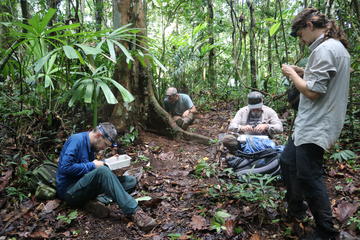
Participants on the ant course in the forest
Image: Juliet Turner
The Ant Course, based in Papua New Guinea in 2023, aims to strengthen a global network of ant researchers, discover new species, and teach early-stage researchers the skills needed to advance their work. It was also an invaluable opportunity to speak to specialists about my project and ensure I had built a well-rounded understanding of ant social evolution.
The course was based at Binatang Research Centre in Madang, a small station of classrooms and bunkrooms built on the edge of a coral reef, and was divided into field and lab work. We travelled deep into the rainforest to collect and record as many different ants as we could find. In times of catastrophic ecosystem collapse, where wildlife is going extinct faster than it is being discovered, efforts such as this are critically important.
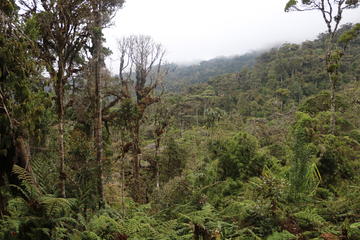
Cloud forest in the highlands of Papua New Guinea
Image: Juliet Turner
The rainforest is not just a habitat; it is a living and breathing tangle of bodies. Ants are so numerous and diverse that they influence and hold everything together. They fragment, reshape, and redistribute the organic materials. They aerate the soil, control invertebrate numbers, pollinate plants, and provide food for many larger animals. Ants invented agriculture millions of years before we did – some create their own monocultures of crops, cultivate fungus, or manage aphids like cattle. Some are subterranean, golden, soft-bodied, and blind – others are huge, with spiked black armour, keen eyes, and fast legs.
In the lab, I saw these tiny animals through a microscope in a way I never had before. I learnt to notice the tiny differences that indicated which lineage they belonged too, and by speaking to others in the field, I gained insights into how these species were shaped over evolutionary time to become the way they are now. Through the course I made new friends from across the world, had the privilege of meeting top researchers whose names I’d known from the papers I read, and I gained confidence in my own work after my presentation was well-received by the expert audience.
Exploring Papua New Guinea
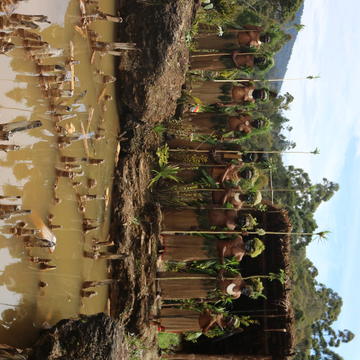
Members of the Yokonda salt pond tribe
Image: Juliet Turner
When the course ended, I embarked on the challenge of exploring Papua New Guinea by myself. After over 20 hours in a minibus from coastal lowland Madang up to the cloudy forests of the highlands, I arrived at my destination: a province called Enga, which first had contact with the outside world in the 1930s, and where many communities live a traditional tribal way of life. I was one of only a handful of foreign visitors to experience the busy Wabag Cultural Show, a festival showcasing the diverse cultures of the region – dances, initiation ceremonies, food making, weaving, clay work, and clothing made from reeds and paradise bird feathers.
For the next two weeks, I was in awe of the human and non-human lives unfolding in the seemingly endless highland forests. My experiences ranged from meeting a tribe who protected the sacred salt ponds of Yokonda to wandering through the cloud forest thousands of metres above sea level – home to towering tree-ferns and giant mosses which made me feel like I had fallen back in time to the Carboniferous Period. Cold early dawns were spent photographing birds of paradise dancing and picking fruit outside my lodge. I met a man called Max who knew every wild orchid growing in the forest like personal friends, and who lived in a hand-built home at the foot of a sleeping volcano, but I also saw the effects of violent tribal fights and the peace process between two warring groups: an exchange of over a hundred pigs, a captured cassowary, a substantial sum of money, and a stack of canned drinks.
I realised only after returning that my insurance would have been invalid; British travel advice for the Papuan highlands is effectively “don’t go”. Regardless, I am exceptionally glad that I did. I even got offered a job as a lecturer at the soon-to-be-built University of Enga by the province’s governor – a networking success I never expected.
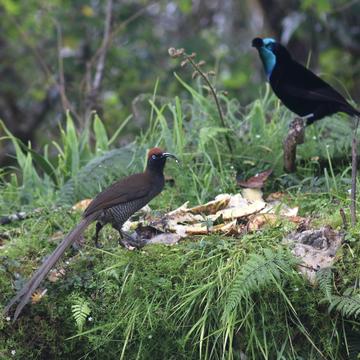
A female Brown Sicklebill and a male Ribbon-tailed Astrapia
Image: Juliet Turner
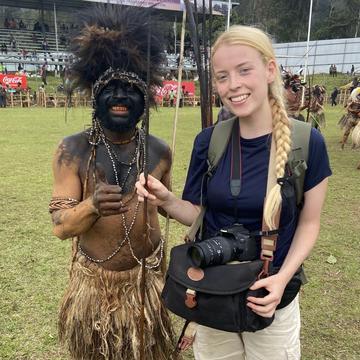
Juliet stands with a participant in the Enga cultural show
Image: Juliet Turner

